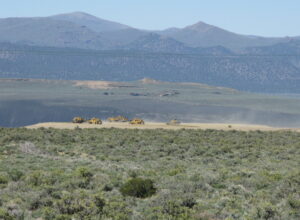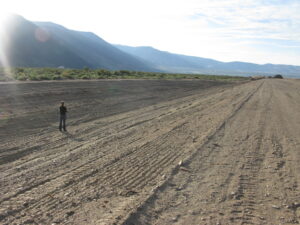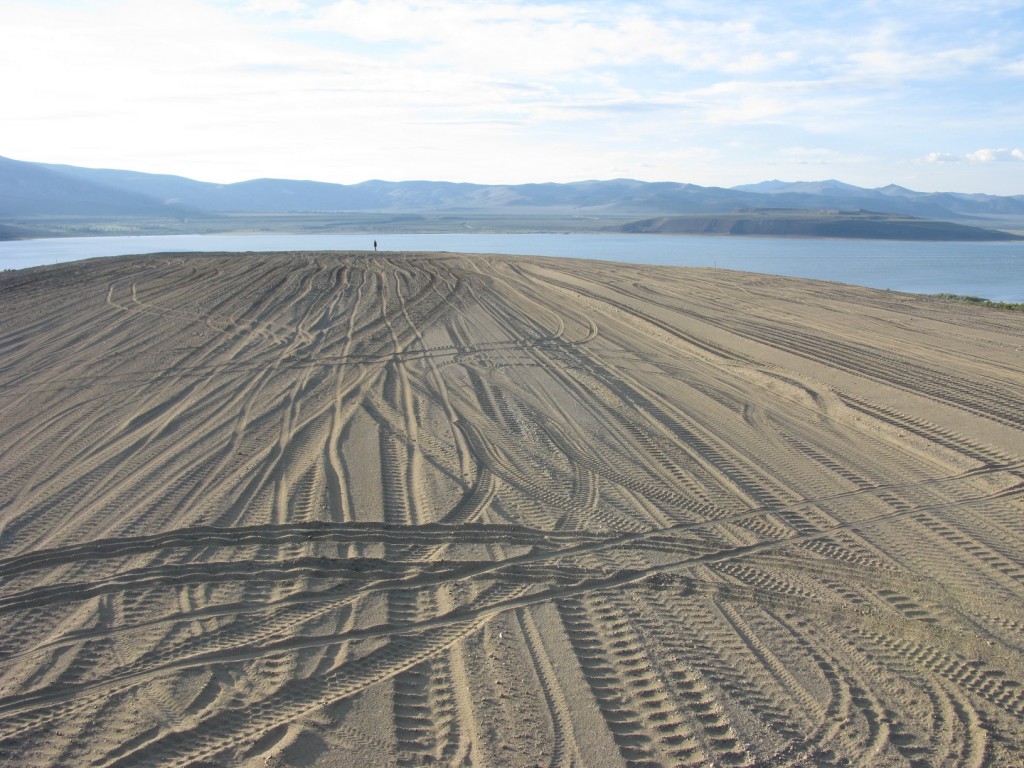
We’ve been receiving calls and inquiries about a large earth construction that has been growing on the hill across from Lee Vining over the past two weeks. The questions are pretty simple: what is that, why is it happening–and is it needed? We’ve been asking questions, and here’s what we’ve found out so far.

Question number one is easy to answer: the project taking place is the rehabilitation of the Lee Vining airport. Yes, Lee Vining has an airport. We’re not surprised if you are surprised by that–it’s a rural airstrip used by small planes and offers no services on site. The plan that had been discussed locally was a rehabilitation project: flatten, widen by ten feet, and resurface the runway, plus improve the lighting used when planes are approaching at night.
From Lee Vining the runway is largely hidden from view. Which leads to the second question: why is a large earthworks of approximately 10 acres in size being constructed? It’s not part of the actual runway, and it turns out that the area in question is simply being used as a place to put excavated dirt.

The impacts of the earthworks are drawing increasing attention and concern. They are highly visible and stand out as an artificial construction, not just from town but also the western lake shore, Conway Summit, the Highway 120 first view of Mono Lake, and the Forest Service Visitor Center. They have covered a substantial amount of habitat. And the revegetation plan for the site does not appear to assure that successful plant establishment and ground coverage will be achieved.
Many residents are just surprised about the scale of the project, given the rules and regulations that apply to private landowners throughout the county.
The Mono Lake Committee is actively seeking more information on the background of the project. While the runway work was discussed and anticipated locally, the earthworks were not and we’re asking how it was designed and approved, and what consideration was made for the scenic views that draw visitors here by the hundreds of thousands.
Given that work is already in progress, the key question is really this: what can be done to reduce the impacts? The Committee is hopeful that solutions can be quickly found to reduce visual impacts, mitigate habitat loss, and assure successful revegetation of the site. More information will be coming soon.


Being there since 1956 the airport probably needs safely updates as it is regulated by the FAA. Check with Mono County who leases it from the City of LA. I don’t remember hearing concerns when the Forest Service built their Visitor Center. There is a building that can be seen from everywhere. When the airport is finished I doubt anyone will see it again.
Thanks Bob, I haven’t heard any opposition to the airport updates (runway widening, flattening, lighting improvements). However the growing concern is about the large earthworks that is not part of the runway or any FAA requirements. The goal would be to be sure no one can see again as you say. We’re checking with Mono County, which is the project lead, to see if the material placement and revegetation plans achieve that goal.
In my opinion it is a must that they re-establish vegetation to the total area that they have abused!!!
I just looks like a dirt pile out there on that mesa, in the viewshed from nearly any point on 395 towards the lake. I hope there is a quick and effective revegetation plan. If not the county has permitted construction of an eyesore in front of one of its crown jewels.
As for the Visitor Center, it’s clearly a building constructed for the purpose in a place that shows off Mono Basin’s natural assets. I don’t think it is a object comparable to the dirt pile.
Hi Tom, you’re right, the revegetation plan is really important. Often these types of projects have revegetation requirements (in this case hydroseeding) but no followup. A better plan is to set a goal, monitor plant recovery, and conduct additional soil treatment/planting/seeding as needed to achieve the goal. This project should take the better approach to be sure vegetation is successfully reestablished.
Based on concerns raised by residents in the Lee Vining community, the Great Basin Air Pollution Control District is investigating this and will require dust from “the pile” to be controlled in the short-term with some type of stabilizer and in the long-term with a revegetation plan. According to Mono County, the pile will eventually be used to extend the runway. However, “eventually” could be 30 years. It appears the pile will be there for quite some time.
The new runway will service about two planes per year, my brother-in-laws C-172 when he drops my wife off to visit and Denis Domailie on occasion “just kidding” there will be a couple more . I can’t believe the way the monies allocated for these types of project was spent. Its disgusting, but what the heck, they took out the high spot in the runway, and graded it to be safer when landing – so I’ll take it.
As for impacts to the environment, I would hope the county acquired the appropriate permits and satisfied any NEPA/CEQA guidelines for the expansion. I am surprised that there are no BMPs around the disturbance footprint. Although, I doubt there will be much of an impact to the environment overall other than a temporary eyesore. One thing I would like to see is some sort of interim seeding of the borrow stockpile and any stormwater diversion structures or “unpaved” areas so we don’t get a bunch of cheat grass started out there. Our local deer herd spends a lot of the winter months in this area and it would be good if the seed mix included native species favorable for mule deer browse.
Great point about the cheatgrass potential Matt. A native seed mix with coverage goals will help assure revegetation with plants the deer favor (I saw deer crossing the construction site just the other day) and will also keep the site from producing a lot of windblown dust come fall. There’s more info to come on this from Mono County.
I am quite confident the area will recover. Safety must be the primary concern of any agency that operates an airport. I consider the safety of those who use the airport far more important than some sagebrush and viewshed. And yes I am a member of the Committee.
I argee 100% with Bob Gregg, and when it is all said and done the airport view will be like before, unless you know its there you will not see it.
David Garcia
Mono Lake Member
geoff: This project had to come up before the county board of supervisors. And the committee should be monitoring the semi monthly board agenda. What happened here? Also, the plan for construction should have required a statement about meeting CEQA requirements. And mailing should have come from the county planning department to groups like ours. Why did this not happen? I assume this project is exempt in CEQA but still a notice of project exemption should have been posted. I can’t understand how no one in lee vining was aware of this project. When the earth movers were trucked in didn’t anyone ask about this with the county? Why should there even be an airport strip here? There is a fine small, and expanding, airport near Convict lake. With a drive to Lee Vining. How about doing a cost analysis on the numbers of planes using it and the cost for maintaining it and expanding it. And then place a charge on those using it. My best shot is to get it removed years from now and not allow any new contruction!!! bill miley, member
Last summer a man staying at Camp Azusa, along Hwy. 120 West, experienced a serious heart difficulty and was evacuated by medical helicopter from the Lee Vining Airport. He’s doing okay now, but without the quick intervention of LV first responders, he might not be alive. I like our area to “look” natural and BE natural; however, I’ve also seen the usefulness of the airport firsthand. Do press for the cosmetic revamping and the revegetation with natural planting.
Gaynelle Rose, Committee member
The safety and value of the airport keep coming up in these comments. While an important part of a comprehensive discussion, these aspects of the airport are not threatened in any way, and in my opinion as a personal user and a fire and medical user of the airport (I’m an EMT/Firefighter on the Lee Vining Volunteer Fire Department), they shouldn’t be questioned. The airport serves an important function, and it does so in a safe manner.
The questions at issue are threefold: public process, environmental impact, and fiscal. And perhaps lack of contractor oversight–a drainage ditch was designed that some say is as large as the California Aqueduct–the source of a lot of the extra soil that wasn’t in the plans to move.
And to chime in on the cheatgrass issue, I agree with Matt that it is a big threat and needs to be mitigated. Just this week I revisited some sites along Rush Creek just downstream and downwind of Highway 395 where we planted Jeffrey Pine seedlings in 2008 and that I hadn’t visited since. There seems to be a lot more cheatgrass in those sites now, and I think it is spreading from the major infestation along the highway (which was reconstructed about 10 years ago). The single biggest thing we can do to contain the spread of cheatgrass is to limit soil disturbance, and aggressively revegetate with natives when it does happen.